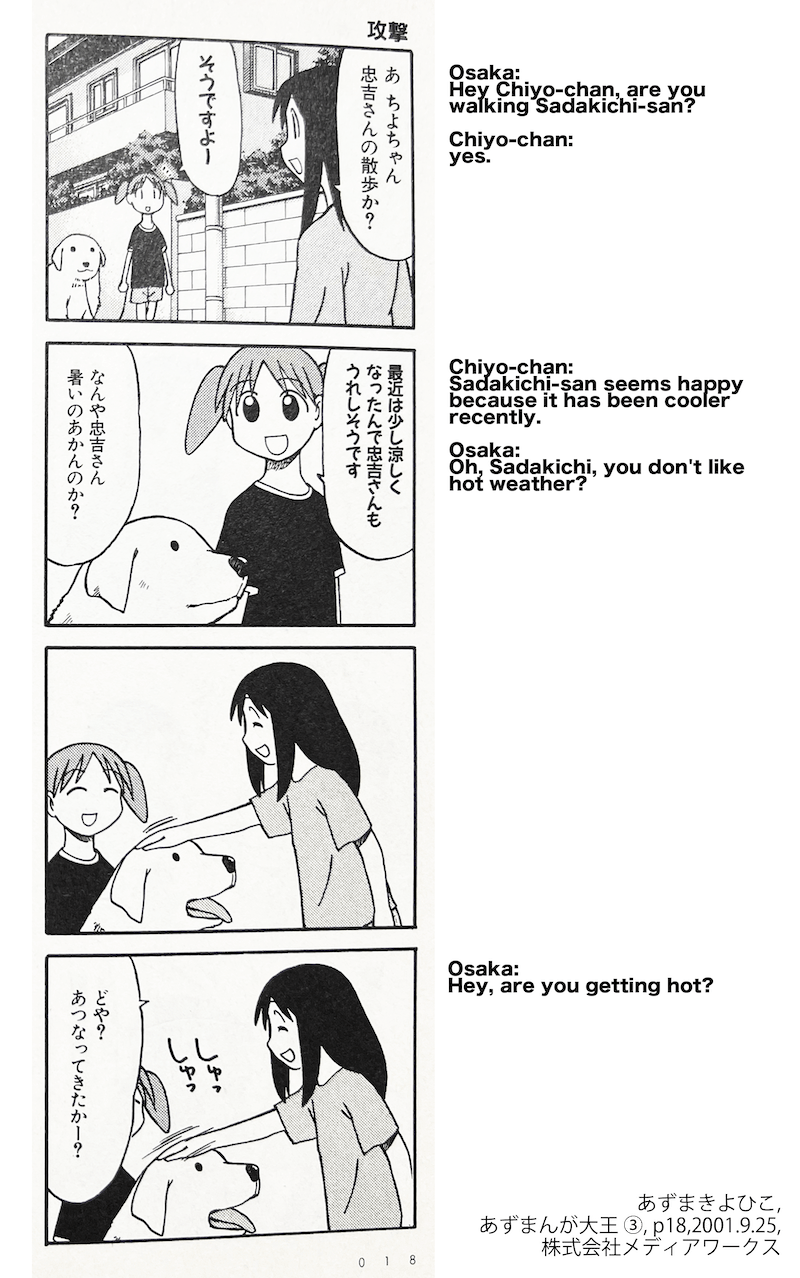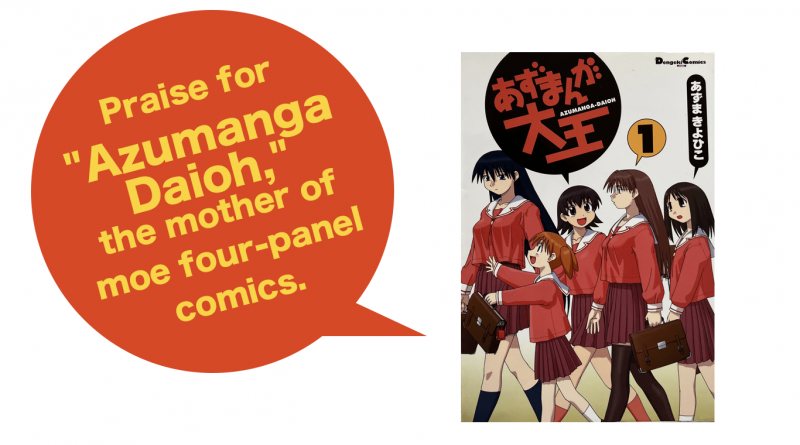Let’s read “Azumanga Daioh,” a manga in the history of otaku.
This article is translated by a Japanese person while using an AI service, so please forgive any unnatural parts.
One of the genres that gained popularity in Japanese otaku culture from the 2000s was “Moe 4-koma,” but what was the work that started its popularity, first serialized in 1998?
(2123, Jeopardy!)
Yes, it’s Azumanga Daioh.
Without that manga, there would be no “Lucky★Star”, no “Yuyushiki”, no “Bocchi the Rock”.
Whether you’ve read Azumanga Daioh or not, let’s confirm its tremendous influence in the manga industry once again, and if you haven’t read it, you should.
Check out a manga lover’s review here.
Summary: Set the Style for Moe × 4-Koma with No Major Events
It was the first 4-koma manga featuring cute girls where no particular event happens, to achieve a major hit.
It demonstrated the pattern for the success of Moe 4-koma, leading to the creation of many such works afterwards.
Without Azumanga Daioh, we wouldn’t have met Bocchi-chan from “Bocchi the Rock”.
Basic Information
Author : Kiyohiko Azuma
Publisher : MediaWorks (original), Shogakukan (reprint)
Magazine : Monthly Comic Dengeki Daioh
Serial : December 18, 1998 – March 21, 2002
Anime Broadcast : April – September 2002
What is Azumanga Daioh about?
- It’s a school-themed comedy 4-koma manga
- Most characters are high school girls, and there is no particular protagonist
- The setting is the three years of high school from the main characters’ admission to graduation
- No particular incidents occur, and daily life is depicted
- There is no particularly sexual description (but it still feels aimed at men)
Historical Context
In 1998, otaku culture was not widely spread, but mainstream manga like Shonen Jump were very popular. Manga, especially Shonen manga, had won a place in the hearts of children.
Also, as can be seen from the opening of Kaiyodo (a figure specialty store) in Akihabara’s Radio Kaikan in 1998, it was an era when otaku culture was growing rapidly.
The number of otaku was increasing due to the popularity of Evangelion and other factors.
Incidentally, 1998 was a time when VHS was still selling more than DVD in Japan, and it wasn’t until 2002 that DVD overtook VHS. It was the era of recording late-night anime on videotapes.
In Japan, there was still a general lack of understanding of anime and otaku culture, and a culture remained where classmates who read core manga were looked down upon.
The existence of otaku didn’t become familiar in Japan until the 2005 drama “Train Man”.
Even though there were quite a few otaku, there was a clear divide between “manga read by ordinary people” and “manga read by otaku”.
If we pull out some random information about anime, manga, and games from before and after the serialization, it looks like this:
- Tokimeki Memorial (PC Engine, etc.): 1994
- Windows95 Release: 1995
- Neon Genesis Evangelion (Anime): 1995 – 1996
- Sakura Wars (Sega Saturn): 1996
- Cardcaptor Sakura (Manga): 1996 – 2000
- Pokemon (Red, Green) Japan Release: 1996
- To Heart (PC Game) Release: May 1997
- HUNTER×HUNTER (Manga): March 1998 –
- Cardcaptor Sakura Clow Card Arc (Anime): April 1998 – June 1999
- Windows98 Release: June 25, 1998
- Shaman King (Manga): June 1998 – August 2004
- Love Hina (Manga): 1998 – 2001
- Mahoromatic (Manga): December 1998 – 2004
- Hikaru no Go (Manga): January 1999 – 2003
- ToHeart (Anime): April 1999 – July 1999
- Kanon (PC Game): June 1999
- The Prince of Tennis (Manga): July 1999 – 2008
- Pokemon Gold Silver (Game Boy Color): 1999
- Ojamajo Doremi Season 1~4 (Anime): February 1999 – January 2003
- Windows ME Release: September 2000
- AIR (PC Game): September 2000
- She, the Ultimate Weapon (Manga): January 2000 – October 2001
- Rumbling Hearts (PC Game): August 2001
- Fullmetal Alchemist (Manga): August 2001 – July 2010
- Manga Time Kirara (4-Koma Manga Magazine): May 2002 –
- D.C. ~Da Capo~ (PC Game): June 2002
- Train Man (Drama): July – September 2005
- Pokemon Ruby & Sapphire: November 2002
It started serialization around the same time as “Mahoromatic”, one of the triggers of maid popularity.
Looking at shonen manga, you can see that it was the same era as Shaman King, Hunter×Hunter, and Hikaru no Go, when Shonen Jump was very popular.
Looking at otaku-oriented works, you can see big titles like Tokimeki Memorial, Neon Genesis Evangelion, and Sakura Wars that are still well-known today, indicating that the community was greatly energized.
Achievements
The series has sold a total of 3.25 million copies (this is the advertising copy for the first edition of the new edition of Volume 3, so the actual number is higher now). As of July 2003, related merchandise sales exceeded 3 billion yen. The series has also been adapted into a game. While it is not for a general audience, it has become a very popular work in the otaku community and established the genre of “Moe 4-koma manga”.
The characteristics of Moe 4-koma manga are as follows:
- The main characters are cute girls
- The story does not have major ups and downs, or these are not emphasized
- There is no significant development in a single episode, or it is weak
- Many of the stories are character-driven, highlighting the characters’ traits and personalities
Works and Magazines that Were Born (Presumably) Because of Azumanga Daioh
After the success of Azumanga Daioh, various Moe 4-koma works were born. Some of them have achieved great success, but they might not have been born without Azumanga Daioh.
- Lucky Star: January 2004? ~
- Minami-ke: March 2004? ~
- Nichijou: November 2006 ~
In particular, Manga Time Kirara, a 4-koma manga magazine created following the popular trend of “Moe 4-koma”, wouldn’t have been born without Azumanga Daioh. This applies to all Kirara series:
- K-ON!
- Is the Order a Rabbit?
- Hidamari Sketch
- Doujin Work
- Laid-Back Camp
- Alone Rock
Also, it should have greatly influenced the daily life manga series, not just 4-koma manga. The character-driven daily life manga targeting otaku could not help but be influenced.
Not Necessarily the Origin of Moe 4-Koma
However, even before “Azumanga Daioh” became popular, there were works similar to “Moe 4-koma”. Therefore, it doesn’t seem to be the first “Moe 4-koma” in history.
In the “4-Koma Manga Reading Blog (Ruins)” , works such as “Momoiro Sisters” (author: Tamami Momose) are mentioned.
Also, 4-koma manga with weak punchlines can be found in anthology comics of popular games, etc.
So, it might be more accurate to say it’s the “first work to hit it big with Moe 4-koma”.
The Charm of Azumanga Daioh
There’s Nothing Special, Yet You Can’t Stop Reading
Despite there being no special storyline, it’s still enjoyable to read. The manga depicts scenes of high school girls going to school, taking classes, and chatting, and it’s a mystery why it’s so fun to read.
There are times when you might find yourself enjoying Azumanga Daioh more than works that were influenced by and created after it. The reasons I feel for this are that the “actions of edgy characters feel natural” and “sometimes their actions exceed expectations”.
In works that are like Azumanga Daioh, they often try too hard to characterize and appeal with cuteness, which results in the characters’ actions feeling unnatural, or they resort to stale, overused jokes. In contrast, Azumanga Daioh feels natural and sometimes has punchlines that exceed your imagination.

This 4-koma strip is one of my favorites. The character “Osaka” stands out well, and the punchline is unexpected.
Reading Azumanga Daioh Today
I love Azumanga Daioh and have reread it many times, so I can’t say I look at it with unbiased eyes. However, I can still enjoy reading it today.
There’s also a new edition available, so those who are bothered by the slightly old-fashioned art style from around the year 2000 can rest assured.
When attempting to write otaku history, this historical work is a name that will always come up. Let’s appreciate that it was born in this era and definitely give it a read.
Check the review on ComicAddict







